-Trending Prospects (12/9) - Doug McDermott, Scott Machado, Henry Sims
-Trending Prospects (12/22) - Kris Joseph, Draymond Green, Chace Stanback
-Trending Prospects (12/23) - Will Barton, LeBryan Nash and Ricardo Ratliffe
-Trending Prospects (12/30) - Mike Moser, Kenny Boynton and Jarrod Jones
-Trending Prospects (1/6) - Herb Pope, Eric Griffin, Otto Porter, Quincy Acy
-Trending Prospects (1/12) - Arnett Moultrie, Kevin Jones, Robbie Hummel, Elias Harris
-Trending Prospects (1/20) - Andrew Nicholson, William Buford, Orlando Johnson, Tyshawn Taylor
-Trending Prospects (1/26) - Jordan Taylor, J'Covan Brown, Ashton Gibbs, Jorge Gutierrez
-Trending Prospects (2/3) - Tu Holloway, Maalik Wayns, Rodney Williams, John Shurna
-Trending Prospects (2/10) - Terrence Ross, B.J. Young, Darius Miller and Isaiah Canaan
-Trending Prospects (2/19) - John Jenkins, Hollis Thompson, Kim English, Elijah Johnson
-Trending Prospects (2/27) - Doron Lamb, C.J. Leslie, Darius Johnson-Odom, Bernard James
-Trending Prospects (3/1) - John Henson, Festus Ezeli, Mike Scott, Kevin Murphy
-Trending Prospects (3/9) Dion Waiters, Mason Plumlee, Fab Melo, Marcus Denmon, Alex Young
-Trending Prospects (3/14) - Bradley Beal, Tony Wroten, Drew Gordon
-Trending Prospects (3/15) - Jeff Taylor, Meyers Leonard and JaMychal Green
-Trending Prospects (3/22) - Jeremy Lamb, Austin Rivers, C.J. McCollum, Garrett Stutz
Tyler Zeller, 7-0, Center, Senior, North Carolina
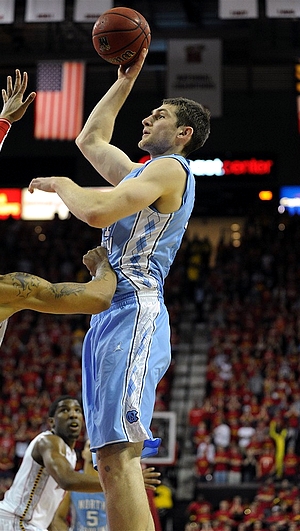
Walker Beeken
Coming into his senior season, Tyler Zeller was a part of a North Carolina team that had high preseason expectations of winning a national title, thanks an extremely talented roster full of top-shelf NBA prospects. The Tar heels ended up earning a number one seed in the NCAA tournament but lost last weekend in the Elite Eight to Kansas, ending Zeller's collegiate career.
After a successful junior year, Zeller continued to make strides as a senior, establishing himself as perhaps the Tar Heels most consistent player and earning ACC Player of the Year honors. While he was considered a likely mid to late first round pick in the 2012 NBA Draft coming into this season, Zeller's impressive senior campaign helped elevate his draft stock to the point that he now has a strong chance of being picked in the lottery or perhaps even the top ten.
His intrigue from NBA standpoint starts with his physical profile, as he's a solid run and jump athlete for a 7-footer, showing great speed running the court, as well as the ability to finish above the rim. Somewhat upright in his stance and not overly fluid, his frame could still use some extra bulk, but he's made progress in that area since coming to North Carolina, and he should continue to add strength as he puts in the work in the weight room.
Zeller combines his outstanding running ability with a nice set of hands and a good motor for a player his size, both of which help him as a finisher sprinting the floor. He's able to beat most any big men down the court and catch the ball running full speed, where he's then shown the ability to quickly gather himself and elevate for a dunk, resulting in him converting on an excellent 79% of his field goal attempts in transition this season.
In the half-court, Zeller does much of his damage in the post, where he looked to be more assertive and confident as a senior, fighting to establish position and calling for the ball. His bread and butter is still his right-handed jump hook turning to his left shoulder, which he executes effectively from either block and can even shoot from a bit further out, depending on how deep he catches the ball.
He'll need to continue to refine his post game, working on his footwork and mixing up his repertoire a bit, but he did show flashes of some counter moves and looks to have good touch finishing with either hand around the rim. He'll also need to focus more on feeling defenders collapsing on him and finding open shooters, as his passing out of the post is still lacking at this stage, only generating an assist on just 7% of his used possessions.
Due to the way he was utilized offensively at North Carolina, Zeller didn't get to show much in terms of his shooting ability, attempting less than one jumper per game in his senior season. He connected on half of those attempts, albeit in a very limited sample size, and looks like he should become a reliable shooter out to about eighteen feet or so in time. He shot an excellent 81% from the free throw line this season, has solid mechanics, and a quick release, which all bode well for his potential to space the floor and pick-and-pop as he gets more comfortable with his jumper.
Defensively, Zeller may lack some girth to defend bigger NBA centers and isn't the most imposing rim-protector (his 2 blocks per-40 minutes ranks 11th of the 15 centers in our top 100 rankings), but he's a very cerebral defender who understands positioning, both defending the ball and in help situations, as he does an excellent job drawing charges. He'll likely never be considered a game-changing defender at the center position, but his smarts and instincts should enable him to fit into a defensive scheme, where he has the potential to excel defending ball screens and making the proper rotations.
Perhaps the area we've noticed the most improvement in Zeller over the past year has been with his toughness and willingness to embrace contact in the paint. We noted before that he seemed to be a bit soft at times and was muscled around on occasion, but he showed more of a mean streak this year on both ends of the floor. After being a below average rebounder for three seasons, Zeller improved dramatically as a senior, showing great activity on the glass on both ends of the floor and grabbing 13.6 rebounds per-40, which was the highest of all centers in our top 100.
Overall, Zeller had a very impressive senior season at North Carolina, solidifying his strengths and shoring up some of his weaknesses. He improved each year since arriving as a freshman and also earned Academic All-American of the Year honors this season, further exemplifying his strong off-court intangibles.
The fact that he's already 22 years and doesn't have elite length or athleticism likely limits his upside in the eyes of NBA decision makers, but 7-footers who can rebound, run the floor, and score in the post are always highly coveted by NBA teams, and Zeller looks to have the potential to make a contribution early in his career if he's drafted by the right team and given the opportunity.
Jared Cunningham, 6-4, Junior, Shooting Guard, Oregon State
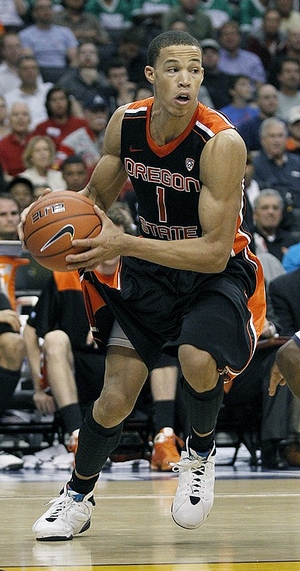
Jonathan Givony
After a solid junior year culminating in first team All-Pac 12 honors, Jared Cunningham will put his name in the draft pool according to recent reports, and appears to be leaning towards moving on to the pro level.
Standing between 6-3 and 6-4, with a skinny frame, Cunningham is somewhat undersized for a NBA shooting guard, but possesses strong athleticism which should help compensate for his average size. He has a good first step and excellent quickness in the open floor, and is capable of playing above the rim, sometimes in highlight reel fashion.
Cunningham spent a little more time playing point guard for Oregon State this year, particularly later in the season, often being asked to bring the ball up the court and initiate the team's offense. He's not a selfish player, looking willing to make the extra pass, especially in drive and dish situations, but he still has to improve at controlling the tempo of the game, limiting careless turnovers and showing better shot-selection and decision making.
Considering his 1/1 assist to turnover ratio and -2.79 pure point ratio (low even amongst shooting guards) it's difficult to say that he'll be able to make the conversion to being a full-time playmaker down the road.
Cunningham's best attributes revolve around using his speed to get out in the open floor and turn the corner in the half-court, something he's able to do frequently on a team that played at the fastest tempo in the Pac-12. He is one of the most efficient scorers in college basketball in transition situations, converting 66% of his field goal attempts and getting to the free throw line at a prolific rate.
Cunningham also does a good job moving off the ball in Oregon State's modified Princeton offense, being a frequent target for teammates to throw lobs to taking advantage of his strong leaping ability.
Where Cunningham is still a work in progress is as a playmaker in pick and roll and isolation situations. While he's capable of blowing by opponents with his excellent first step, he doesn't show the ability to operate at different speeds, and is just an average overall ball-handler in the half-court. Cunningham struggles to get all the way to the rim, often electing to settle for tough floaters from 5-7 feet away that are not particularly high percentage shots. Cunningham lacks some size and strength to help him finish in traffic, and tends to avoid contact at times around the rim, raising some questions about his toughness. Nevertheless, Cunningham ranked among the top-50 players in the country in fouls drawn, showing that he does have very good potential in this area.
The other area where Cunningham must improve in the most is as a perimeter shooter. He attempted over four 3-pointers per game this season, but converted just 34%. While he shows solid mechanics and is capable of making shots with his feet set, particularly in rhythm, he struggled badly shooting the ball off the dribble this season, hitting just 17 of his 74 pull-up jumpers.
Part of this has to do with his average shot-selection, but the considerable role he was forced to shoulder on a team that does not have very much talent around him obviously was a factor as well. All things considered, is does not appear that his jumper is broken and it's certainly not out of the question that he ends up being at least a decent shooter as a pro if he puts the work in.
Defensively, Cunningham has real virtues, as evidenced by the fact that he was named to the Pac-12 all-defensive first team, despite playing on the conference's fourth worst defense.
On one hand, he has quick feet and excellent anticipation skills, helping him rank in the top-10 amongst all prospects in steals this season, and #1 last season.
His average size and frame might make it difficult at times to keep up with some of the bigger and more physical shooting guards he'll encounter in the NBA, but his peskiness and ability to put excellent pressure on the ball will surely work in his favor on this end of the floor.
Finishing just 7-11 in the weak Pac-12, and not really showing much improvement over last season statistically, Cunningham is not entering the draft with a great deal of momentum behind him. While he has some interesting characteristics with his strong athleticism, ability to score in transition and defensive merits, he will need to have strong private workouts if he's to improve his stock enough to justify forfeiting his senior season.
Yancy Gates, 6'9, Power Forward, Senior, Cincinnati
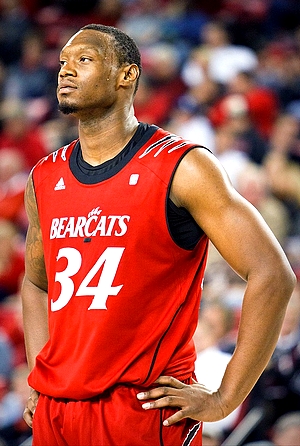
Kyle Nelson
Cincinnati senior Yancy Gates had quite an eventful senior year, rebounding from the nasty brawl and six-game suspension to lead the Bearcats to the Sweet Sixteen. Though he disappeared down the stretch in a loss to Ohio State, he showed enough throughout the season to plant himself back on the NBA radar. Now, as his time at Cincinnati is over, scouts must decide whether his legitimate talent and potential trumps the long list of red flags that he has built up throughout his career.
At 6'9, with an excellent 7'3 wingspan and a massive 260-pound frame, Gates possesses good size for an NBA big man. He is solid athlete, as well, explosive around the basket, though probably more mobile than he is quick. Despite his good physical profile, improving his conditioning would do wonders for both his physique and athleticism, not to mention his standing with NBA teams.
On offense, Gates is more or less the same player that we profiled at the beginning of his senior season, displaying a combination of post play with some spot-up shooting and face-up potential. That being said, it's worth noting that Gates's 15.7 points per 40 minutes pace adjusted on just 46% from the field were both career lows this season.
In the post, Gates still lacks much of a post game, relying more upon brute strength than polished footwork. He still has a nice jump hook in his repertoire and can surprise his man with a quick spin on the baseline, but he is not consistently aggressive and rarely uses his size to his advantage at this level. Another issue is that Gates does not consistently post up, however, preferring to pull up or fade away than take his man to the basket.
His often inconsistent or uninspired aggressiveness and focus is a significant reason why he struggles to get to the foul line and why shoots such a low percentage from inside of the arc, as he rarely puts himself in position for easy baskets. When he's dialed in he's an asset in the post, carving out space and using his strength and athleticism to get to the basket, but you never quite know what to expect from Gates, as his performances fluctuate greatly depending on what day you catch him on.
Gates also sees his fair share of offense away from the basket, where he finds over 25% of his field goal attempts. Unfortunately, Gates is still not a great shooter, making just 31% of his jump shots according to Synergy without the shot selection or free throw percentage to suggest he is a better shooter than meets the eye. His release does not look bad, but he tends to fade away when he shoots, even with his feet set. Needless to say, he must work on his mechanics and decision making quite a bit before proving to scouts that he is a capable jump shooter.
One area where Gates has visibly improved, however, is on the offensive boards. As a senior, Gates was one of the better offensive rebounds in the country averaging 4.1 offensive rebounds per 40 minutes pace adjusted. Though he doesn't usually box out, his combination of strength, soft hands, length, instincts and leaping ability allow him to grab offensive rebounds and bring the ball straight back up to the basket. If he's able to improve his effort and focus-level as he matures he could be a very good offensive rebounder and finisher.
Gates is a solid defender, as well, showing very good lateral quickness for his size with the ability to stay in front of his man inside and outside. In the post, he does not make much of an effort to deny his man the ball, but he does an excellent job of standing his ground and forcing his man into tough shots. As is the case elsewhere in his game, focus can be an issue here and staying in his stance would help him significantly, but he should not be a liability guarding power forwards at the next level. He has proven to be a good rebounder, as well,grabbing a career-high 11.5 rebounds per 40 minutes pace adjusted
Nevertheless, Yancy Gates is a difficult player to project at the next level. On one hand, he has an excellent physical profile with an interesting skill set and significant potential. On the other hand, he has a myriad of red flags, from the Xavier brawl to his shoddy conditioning, his multiple suspensions to his inconsistent effort. Gates certainly has the talent to get drafted and could have a lot of value to a team if he's able to overcome the issues that have plagued him throughout his career. In the meantime, Gates must do everything in his power to prove that his past his behind him while showing greater effort on both ends of the floor.
Kyle O'Quinn, 6'10, Power Forward/Center, Senior, Norfolk State
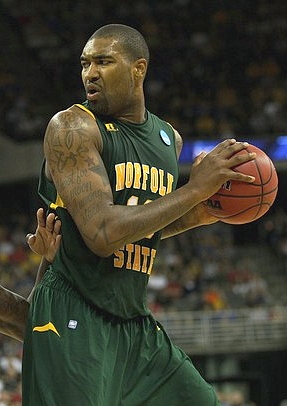
Kyle Nelson
After leading Norfolk State to its first NCAA Tournament in school history, big man Kyle O'Quinn continued an already memorable senior season by powering #15 seed Spartans to victory against #2 seed Missouri. O'Quinn posted 26 points, 14 rebounds, and 2 blocks on college basketball's biggest stage in one of the most shocking upsets in NCAA Tournament history against Ricardo Ratliffe, a legitimate prospect in his own right. Though Florida would ultimately shut down O'Quinn and end Norfolk State's tournament run in the round of 32, O'Quinn validated many of the strengths and weaknesses we observed last November, though against superior competition.
At first sight, O'Quinn more than looks the part of a NBA big man, standing 6'10 with a solid 240-pound frame and a long wingspan. He is a below average athlete at best, however, lacking much in the way of standout quickness or explosiveness. While this was hardly exposed against MEAC opponents, his struggles against Florida and Marquette, in particular, seem to be fairly prescient of the trouble he may have adjusting athletically to the next level.
On offense, O'Quinn is a versatile, albeit unorthodox player, demonstrating the ability to score around the basket and from the perimeter while averaging 19.5 points per 40 minutes pace adjusted and shooting an incredibly efficient 61% from inside of the arc.
Nearly 30% of his offensive possessions come in the post, where, according to Synergy Sports Tech, he converts a solid 54.8% of his attempts. On film, O'Quinn still shows a solid arsenal of post moves with his back to the basket, even if his lack of quickness and explosiveness remains a significant concern projecting to the next level. So too does the fact that he struggled so mightily against Florida and Marquette's post defense, where he wasn't able to simply bully his opponents with sheer strength the way he's accustomed to. O'Quinn looks excellent in the post against weaker MEAC competition, but with few exceptions he remains largely unproven against NBA-caliber post defenders.
Another area of concern is his unorthodox perimeter game. By the numbers, O'Quinn is an awful perimeter shooter, connecting on just 18.8% of his attempts and failing to crack 30% shooting since his freshman year. As we have expressed in the past, his miserable shot selection seems to be the primary culprit, though he could certainly stand to develop more consistent shooting mechanics. Moving inside of the arc, he a bit more successful, occasionally showing the ability to knock down spot-up jump shots from mid-range.
Also worth mentioning is his much-improved aggressiveness and focus in the post in the post, reflected in his career high 7.6 free throw attempts per 40 minutes pace adjusted and his willingness to take the ball stronger to the rim, He has also done a better job of moving without the ball this season, as well, and does a good job of finishing off of cuts.
The only way to classify O'Quinn's offense is as unorthodox because he tries to do so much with mixed results and it still remains to be seen what exactly he'll be able to do consistently against NBA-caliber defenders. We likely will not see him launching contested 30-footers or taking his man off of the dribble from the perimeter at the next level, but O'Quinn's ability to hit mid-range jump shots, crash the offense boards, and finish off cuts are all legitimate, coveted skills.
On defense, O'Quinn is a mixed bag, as he dominated subpar competition on a nightly basis for almost four years with a very limited sample size of what he can actually do against high-major competition. In games against Florida, Missouri, Marquette, and Virginia Tech, O'Quinn strung together impressive defensive possessions, but struggled to maintain his focus. In general, he seemingly lacks the lateral quickness to guard more perimeter-oriented big men and his general awareness does not look great. Furthermore, he struggles to close out on shooters, looking slow-footed and uninterested at times.
That being said, he is an excellent shot blocker, largely because of his long wingspan, and his 3.3 blocks per 40 minutes pace adjusted, for the second straight year, ranks him amongst the top players in our database for the second consecutive year. .
While he was an fringe prospect coming into this season, he is certainly on scouts radars now. Far from being an elite prospect, O'Quinn is an ideal player for the Portsmouth Invitational Tournament, where scouts will be watching to see if he can continue to score and rebound while showing improved decision making against better competition. In addition to good showings in Portsmouth and in private workouts, he should also prioritize improving his conditioning, so as to maximize both his physical and athletic potential. His NCAA tournament performance was revealing, but it is within a larger body of work and O'Quinn still has quite a bit of work to do before he's a lock to hear his name called on draft night.













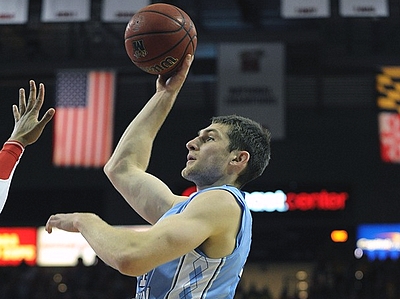


















Comments